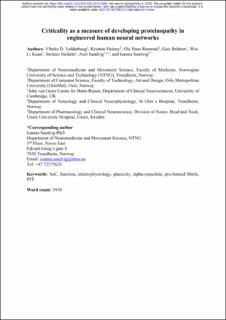| dc.contributor.author | Valderhaug, Vibeke Devold | |
| dc.contributor.author | Heiney, Kristine | |
| dc.contributor.author | Huse Ramstad, Ola | |
| dc.contributor.author | Bråthen, Geir | |
| dc.contributor.author | Kuan, Wei-Li | |
| dc.contributor.author | Nichele, Stefano | |
| dc.contributor.author | Sandvig, Axel | |
| dc.contributor.author | Sandvig, Ioanna | |
| dc.date.accessioned | 2021-03-24T09:53:00Z | |
| dc.date.available | 2021-03-24T09:53:00Z | |
| dc.date.created | 2020-05-06T12:19:43Z | |
| dc.date.issued | 2020 | |
| dc.identifier.citation | BioRxiv. 2020, . | en_US |
| dc.identifier.issn | 0362-4331 | |
| dc.identifier.uri | https://hdl.handle.net/11250/2735243 | |
| dc.description.abstract | A patterned spread of proteinopathy represents a common characteristic of many neurodegenerative diseases. In Parkinson’s disease (PD), misfolded forms of alpha-synuclein proteins aggregate and accumulate in hallmark pathological inclusions termed Lewy bodies and Lewy neurites, which seems to affect selectively vulnerable neuronal populations and propagate within interconnected neuronal networks. Research findings suggest that these proteinopathic inclusions are present at very early timepoints in disease development, even before strong behavioural symptoms of dysfunction arise, but that these underlying pathologies might be masked by homeostatic processes working to maintain the function of the degenerating neural circuits. This study investigates whether inducing the PD-related alpha-synuclein pathology in engineered human neural networks can be associated with changes in network function, and particularly with network criticality states. Self-organised criticality represents the critical point between resilience against perturbation and adaptational flexibility, which appears to be a functional trait in self-organising neural networks, both in vitro and in vivo. By monitoring the developing neural network activity through the use of multielectrode arrays (MEAs) for a period of three weeks following proteinopathy induction, we show that although this developing pathology is not clearly manifest in standard measurements of network function, it may be discerned by differences in network criticality states. | en_US |
| dc.language.iso | eng | en_US |
| dc.publisher | BioRxiv | en_US |
| dc.rights | Attribution-NonCommercial-NoDerivatives 4.0 Internasjonal | * |
| dc.rights.uri | http://creativecommons.org/licenses/by-nc-nd/4.0/deed.no | * |
| dc.title | Criticality as a measure of developing proteinopathy in engineered human neural networks | en_US |
| dc.type | Journal article | en_US |
| dc.description.version | submittedVersion | en_US |
| dc.source.pagenumber | 22 | en_US |
| dc.source.journal | BioRxiv | en_US |
| dc.identifier.doi | https://doi.org/10.1101/2020.05.03.074666 | |
| dc.identifier.cristin | 1809648 | |
| dc.relation.project | Norges forskningsråd: 270961 | en_US |
| dc.relation.project | Samarbeidsorganet mellom Helse Midt-Norge og NTNU: x | en_US |
| dc.description.localcode | This article is a preprint and has not been certified by peer review. | en_US |
| cristin.ispublished | true | |
| cristin.fulltext | original | |

